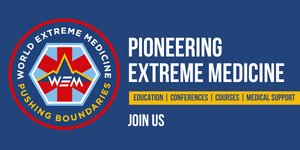Dr Anna Schumann / FY2 / South East London Hospitals
With a keen interest in the global diversity of remote and pre-hospital medicine, Anna took the opportunity to explore a range of settings for her undergraduate medical elective in 2016. Travelling first to the Kathmandu valley in Nepal where she worked in a city hospital and remote health-camp, she then left the heat for the cold, flying to Tromsø in the Arctic Circle, to get a flavour of Norway’s world-class pre-hospital care system.
First stop: Nepal, where I began my elective with a week working in the Emergency Department of a busy urban hospital near the capital, Kathmandu. As I was curious about the reality of humanitarian medicine and keen to gain some experience of what working with an organisation such as Médecins Sans Frontières might be like, my urban placement was followed by an internship at a relatively resource-poor hospital in Manthali, where the local population was still dealing with the aftermath of a devastating earthquake.
In addition to helping with outpatient clinics at the hospital, at the weekends two other UK volunteer doctors and I helped the Medical Chief to run remote health-camps. We drove out to local villages by Jeep, stocked up with as much medication and kit as we could carry. We saw several hundred patients per day, most of whom rarely got the opportunity to see a healthcare worker. We did our best, despite rudimentary knowledge of the local dialect and very limited clinical and diagnostic resources.
My most memorable experiences at Manthali hospital were those from the maternity unit. One night, I was asked to assist with an emergency Caesarean section. Prior to this, I’d only ever seen deliveries in London hospitals, fully supported by midwives, obstetricians and anaesthetic and theatre teams. I felt somewhat out of my comfort zone, working in a team of only three to deliver the baby. Fortunately, the procedure went smoothly and both mother and newborn were well. I attended another vaginal delivery that night, which I am sure would been managed with a working epidural and plenty of analgesia in the UK. Watching a Nepali mother bite down on a piece of cloth and squeeze my hand for ‘pain relief’ during labour was a sobering experience.
After getting a flavour of the challenges of practising medicine in resource-poor and remote settings in Nepali, I set off back to Europe and into the midnight sun, to Norway’s northernmost hospital in Tromsø, 350 km north of the Arctic circle. I thought that a placement in Scandinavia, world renowned for its high standard of healthcare as well as its extraordinarily remote medical services, would be an interesting contrast to healthcare (and temperatures!) in rural Nepal.
Ever since I first heard about the Anna Bågenholm hypothermia case (‘Resuscitation from accidental hypothermia of 13·7°C with circulatory arrest’ ), I had dreamed of meeting the kind of anaesthetists who helped to achieve such a great recovery against all odds. After many emails and phone calls I managed to arrange an observership with Tromsø’s HEMS team via the Universitetssykehuset Nord-Norge’s (University Hospital of North Norway) Anaesthesiology and Critical Care Department
I was warmly welcomed and fully integrated into the medical team thanks to the friendly and multilingual staff and patients. I got daily practice in inserting IV lines, placing airway adjuncts, performing common airway manoeuvres (which I learned quickly look a lot easier than they really are), intubation and ventilation, as well rapid sequence induction.
The highlight of my elective was my final week spent with the Norwegian Air Ambulance HEMS team: I got to work and fly with the HEMS duty doctor, rescue man and pilot. During my time with the team, I got to see the base and dispatch centre, attend morning video-conferences with other remote bases, and (most excitingly) to join several missions across the vast fjord lands of Norway and Finland. During my placement, the team was called out for two search and rescue missions, two critical care inter-hospital transfers, two remote transfers of medically unwell patients and attended one homicide. I absolutely loved every minute of being part of this incredible medical team and watching how calmly they worked under pressure.
The opportunity to contrast emergency, critical care and remote medicine in a developing country with developed Western anaesthesia and pre-hospital care was a real insight and a great privilege. My placement in Norway allowed me to develop my knowledge and competencies in anaesthesia and my enthusiasm for pre-hospital care, while my time in Nepal enhanced my appreciation for the standards of care we take for granted in Europe. I would encourage any other medical student to get creative and to ‘pick-and mix’ when planning their elective.
Information
Manthali, Ramechapp, Nepal / Rural Assistance Nepal (RAN) organises electives here including at Tamekoshi Co-operative Hospital. Aim to stay for at least 3-4 weeks.
Dhulikel, Kathmandu, Nepal / Dhulikel is the teaching hospital for Kathmandu’s University and is the fanciest of Nepali hospitals. Placements are popular and they take a small fee. Contact them here.
Tromsø, Norway / Placement was organised via the University Hospital of North Norway. Make sure you have up to date (within the last 3 months) MRSA swabs via your Occupational Health department. They will not accept you unless you screen negative – Norway is MRSA free!













